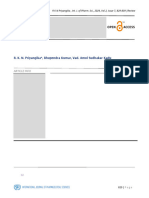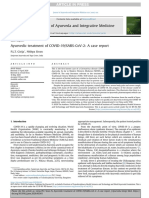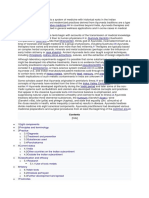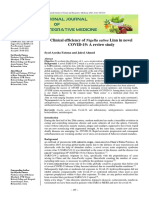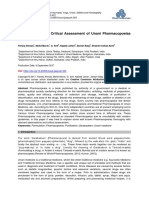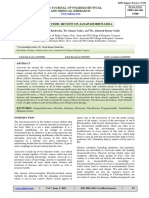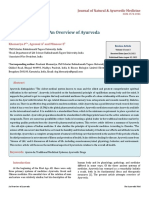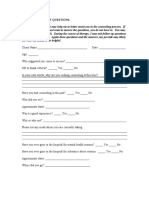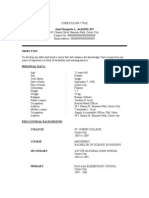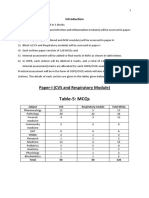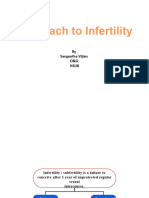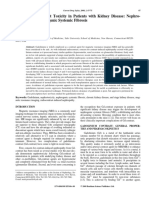0 ratings0% found this document useful (0 votes)
53 viewsInternational Journal of Ayurveda and Pharma Research
International Journal of Ayurveda and Pharma Research
Uploaded by
Manoj VeerakumarThis document discusses the Ayurvedic practice of Dhumapana (medicated smoking) and Dhupana (medicated fumigation) as potential treatments for COVID-19. It analyzes the Dhuma Yoga formulation, which contains Cannabis and four other herbs. Research shows the herbs have properties like fast diffusion and neuroprotective effects. A review of literature indicates Dhuma Yoga's combination of researched herbs may help symptoms like cough and breathing difficulties associated with COVID-19. The document evaluates this Ayurvedic approach as a possible complementary treatment during the pandemic.
Copyright:
© All Rights Reserved
Available Formats
Download as PDF, TXT or read online from Scribd
International Journal of Ayurveda and Pharma Research
International Journal of Ayurveda and Pharma Research
Uploaded by
Manoj Veerakumar0 ratings0% found this document useful (0 votes)
53 views13 pagesThis document discusses the Ayurvedic practice of Dhumapana (medicated smoking) and Dhupana (medicated fumigation) as potential treatments for COVID-19. It analyzes the Dhuma Yoga formulation, which contains Cannabis and four other herbs. Research shows the herbs have properties like fast diffusion and neuroprotective effects. A review of literature indicates Dhuma Yoga's combination of researched herbs may help symptoms like cough and breathing difficulties associated with COVID-19. The document evaluates this Ayurvedic approach as a possible complementary treatment during the pandemic.
Original Title
Untitled
Copyright
© © All Rights Reserved
Available Formats
PDF, TXT or read online from Scribd
Share this document
Did you find this document useful?
Is this content inappropriate?
This document discusses the Ayurvedic practice of Dhumapana (medicated smoking) and Dhupana (medicated fumigation) as potential treatments for COVID-19. It analyzes the Dhuma Yoga formulation, which contains Cannabis and four other herbs. Research shows the herbs have properties like fast diffusion and neuroprotective effects. A review of literature indicates Dhuma Yoga's combination of researched herbs may help symptoms like cough and breathing difficulties associated with COVID-19. The document evaluates this Ayurvedic approach as a possible complementary treatment during the pandemic.
Copyright:
© All Rights Reserved
Available Formats
Download as PDF, TXT or read online from Scribd
Download as pdf or txt
0 ratings0% found this document useful (0 votes)
53 views13 pagesInternational Journal of Ayurveda and Pharma Research
International Journal of Ayurveda and Pharma Research
Uploaded by
Manoj VeerakumarThis document discusses the Ayurvedic practice of Dhumapana (medicated smoking) and Dhupana (medicated fumigation) as potential treatments for COVID-19. It analyzes the Dhuma Yoga formulation, which contains Cannabis and four other herbs. Research shows the herbs have properties like fast diffusion and neuroprotective effects. A review of literature indicates Dhuma Yoga's combination of researched herbs may help symptoms like cough and breathing difficulties associated with COVID-19. The document evaluates this Ayurvedic approach as a possible complementary treatment during the pandemic.
Copyright:
© All Rights Reserved
Available Formats
Download as PDF, TXT or read online from Scribd
Download as pdf or txt
You are on page 1of 13
ISSN: 2322 - 0902 (P)
ISSN: 2322 - 0910 (O)
International Journal of Ayurveda
and Pharma Research
Review Article
SCIENTIFIC EVALUATION OF DHUMA YOGA (AN AYURVEDIC FUMIGATION MEDICINE) AS
PREVENTIVE AND CURATIVE ON SYMPTOMS OF COVID-19 DISEASE
Siva Ram
Chief Doctor, R&D, Charaka Hanf Pvt. Ltd., Odisha. India.
ABSTRACT
Covid-19, an infectious disease caused by a novel coronavirus SARS-CoV-2 spreads primarily
through droplets of saliva or discharge from the nose when an infected person talks, coughs or
sneezes where the viruses are active in the environment within the suspended micro droplets.
Sanitization of environment to weaken/terminate the virus and halting the replication of virus
inside the host along with symptomatic treatment is the primary approach to end the pandemic. In
Ayurveda, Dhupana (medicated fumigation of vicinity) and Dhumapana (medicated smoking)
therapies done by drugs of herbal/animal/mineral origin are a swift way to decontaminate the
environment and Respiratory system. Dhuma (medicated fumes) is a unique drug delivery system
acting directly on respiratory tissues which can deliver quick results in this Covid-19 pandemic by
its local and systematic effects recommended by AYUSH ministry in the guidelines for Covid-19. We
intend to put forward the scientific explanation of powerful Ayurvedic Cannabis based polyherbal
dhumapana (medicated smoking) medication named Dhuma Yoga available in the market as an
alternate remedy for Covid-19 whose four out of five herbal ingredients are in the list of WHO
manual of traditional medicine. We emphasized on Vijaya (Cannabis sativa Linn.) as the centre of
formulation because it is a Rasayana (rejuvenative) herb having Vyavayi (fast acting) and Yogavahi
(synergetic) properties. Phytochemicals of all the herbal ingredients of Dhuma Yoga formulation are
studied through in silico, In vitro and In vivo studies for Covid-19 with favourable outcomes.
KEYWORDS: Dhumapana, Dhupana, Dhuma, Herbal smokes, Fumigation, Cannabis.
INTRODUCTION
The Covid-19 pandemic is causing damage to viruses in environment is comparable to polluted air
public health irrespective of developed and and land which may cause Janapadodhwamsa or
developing nations across the globe. This disease is Maraka, a broad term used for epidemic or pandemic
caused by the virus classified as SARS (severe acute in Ayurveda.[4] The word Virus is derived from Latin
respiratory syndrome) due to its nature of inducing language which means poison.[5] The Covid-19
direct infection in respiration system with disease caused by SARS-CoV-2 can be compared to
suffocation and breathing disorders, hence named Bhuta, Rakshasa, Graha, etc, a kind of microbes
SARS-CoV-2. As per WHO (World Health elucidated in Ayurveda which may cause
Organisation) modes of SARS-CoV-2 transmission is Bhutabhishangaja Jwara (fever caused by invisible
mainly by droplets and also airborne through organisms), a kind of Agantu Jwara (fever caused by
aerosols (micro particles/droplets).[1] Researchers external factors) negatively effecting Pranavaha
are striving to investigate anti-viral drugs, immunity srotas (the vessels carrying the vitals) related to
modulators and vaccines for SARS-CoV-2 with not Lungs, Heart and Brain.[6]
much efficacy and bringing backend side effects too Respiratory disorders like Swasa (asthma,
like the steroid medications which cause immune dyspnoea/breathing difficulty), Kasa (cough)
suppression.[2] developing in deadly diseases like in Covid-19
Ayurveda, the science of life is an Indian pandemic require quick relief and Dhuma (medicated
medical science well established and practiced for fumes) is one such rapid drug delivery method in
several thousand years which is the oldest medicinal Ayurveda which gives various local and also systemic
literature known to mankind and traditionally effects in Vata and Kapha Dosha origin diseases by
considered a part of Adharvana Veda (4th text of swiftly entering the circulation through inhalation
ancient Indian knowledge).[3] The exposure to giving instant results mainly acting on
droplets/ aerosols contaminated with novel corona Urdhvajatrugata roga (diseases/disorders of head
IJAPR | June 2021 | Vol 9 | Issue 6 1
Int. J. Ayur. Pharma Research, 2021;9(6):1-6
and neck) and respiratory system.[7] Acharya Charaka body and mind for improving immune system and
advised to perform fire ritual like Yagna, etc, a kind of fitness of the body to help tackle the Covid-19
Dhuma (medicated fumes) in Janapadodhwamsa disease.
(pandemic diseases).[8] Dhuma (medicated fumes) Vyavayi guna (fast diffusing quality) is a
shows predominance of Agni (fire) and Vayu (air) of specific property of few herbs in Ayurveda which
Panca-mahabhuta (five fundamental elements) first spreads/ circulates quickly throughout the body
having subtle, microscopic and all-pervading quality to exert its action and them undergoes Paka
known as Sukshma guna which helps in enhanced (digestion).[14] Sattva (goodness) is the purest quality
bioavailability and quick spread of medicine into all among the three primary attributes of mind which is
the nooks and corners of the head and neck regions. said to be required for homeostasis in the neuronal
On the basis of mode of administration there are two impulses which triggers all the physiological
varieties of Dhuma (medicated fumes) one is functions in the body.[15] Medhya (intellect
internally given to a patient as a part of inhalation promoting) is also a unique quality among certain
therapy called Dhumapana (medicated smoking/ herbs to help maintain the neuronal health and
inhalation therapy) and the other Dhupana psychological balance.[16] Vajikarana-Rasayana
(medicated fumigation of vicinity) which is (aphrodisiac and rejuvenative) herbs are the best in
fumigation of the environment commonly performed improving and maintaining energy levels, stamina
in ceremonies of holy places, during fire ritual like and storm and to an extent halting the replication of
Homa, Havana, Yajna and in wards of Ayurvedic SARS-CoV-2 which will be explained below in brief.
hospitals viz. Sutikagara (labour wards), Kumaragara There are more than 200 formulations of Vijaya
(paediatric wards), Vranitagara (post-operative), etc, (Cannabis sativa Linn.) in Ayurveda that are mostly
for benefits like Rakshoghna (ward off infectious unexplored.[19]
microorganisms), krimi-hara (anti-parasitic), We searched online journals for scientific
Balagraha-nasa (attenuate microbes that specifically research articles on Elsevier, PubMed, Research Gate,
affect newborn and children), bhutagraha-nasa Science Direct, Medline, Google Scholar, Semantic
(attenuate disease causing microbes) to sanitise the Scholar, Ayush research portal, etc, for Ayurvedic
atmosphere from infectious bacteria, virus, fungi, etc herbs useful in Covid-19 disease; in parallel also
harmful organisms. Dhupana (medicated fumigation explored classical Vijaya (Cannabis sativa Linn.)
of vicinity) is frequently used for sterilizing the pots based Dhumapana or Dhupana formulations with
in which medicines are to be prepared or stored.[9] It respect to ailments Viz. Swasa (Asthma, Dyspnoea),
is also used for quick modulation of muscular and Kasa (Cough) in the classical Ayurvedic texts listed in
connective tissue function like in Garbhasanga the first schedule of drugs and cosmetics act (1940)
(obstructed labour), Aparasanga (retained placenta), that are presently available in the AYUSH medical
Arsas (piles) and also shows systemic effects in Jwara shops or online pharmaceutical markets having such
(fevers), Visha (poisoning), Unmada (psychosis), etc combination of researched herbs on Covid-19.
ailments. [10]
RESULTS
MATERIALS AND METHODS
We found only one classical Cannabis based
Ayurveda divides the universe into two broad Ayurvedic Dhumapana formulation available in the
categories: Sthavara means immobile beings which market called Dhuma Yoga from a GMP certified
include plants, minerals and Jangama means mobile Ayurvedic company Charaka Hanf Pvt. Ltd.[20] Dhuma
beings which include animal kingdom, micro- Yoga is a polyherbal formulation taken from a
organisms, etc. For every disease that is caused by classical book Siddha yoga sangraha, containing
any Jangama, there exists a cure from Sthavara.[11] herbs Viz. Vasa (Adhatoda vasica Nees.), Kala Dhatura
Likewise Virus like SARS-CoV-2 which is included in (Datura metel Linn.), Vijaya (Cannabis sativa Linn.),
Jangama category can be cured by plant or mineral Cavya (Piper retrofractum Vahl.) and Parasika yavani
based medicines. Globally accepted potent herbal (Hyoscyamus niger Linn.).[21] In silico, In vitro and In
based (Sthavara) medicines are required to quickly vivo research is available on the phytochemicals of
address the damage/infection caused by the Covid- these five herbal ingredients for symptomatically
19 disease. Immune modulators, anti-inflammatory treating Covid-19 and also inhibiting the replication
drugs and symptomatic treatment are the main focus of SARS-CoV-2 with positive outcomes which will be
in tackling the Covid-19 disease by AYUSH discussed below in brief. Dhuma Yoga is indicated for
personnel.[12,13] So, apart from looking for a rapid Swasa (Asthma, Dyspnoea/breathing difficulty) as
drug delivery system like Dhuma (medicated fumes) per the classical Ayurvedic text.[21] The above herbal
we focused on certain attributes said in Ayurveda coarse powder is used as an inhalation therapy and
which are required for the quick stimulation of both can also be fumigated to sanitise the environment.
Available online at: http://ijapr.in 2
G. Siva Ram. Scientific Evaluation of Dhuma Yoga As Preventive And Curative on Symptoms of Covid-19 Disease
Table1: Showing the herbal ingredients of Dhuma Yoga [22]
S.No. Sanskrit name Scientific name Family Part used
1. Vijaya Cannabis sativa Linn. Cannabinaceae Leaf
2. Kala Dhatura Datura metel Linn. Solanaceae Leaf
3. Vasa Adhatoda vasica Nees. Acanthaceae Leaf
4. Cavya Piper retrofractum Vahl. Piperaceae Root
5. Parasika yavani Hyoscyamus niger Linn. Solanaceae Leaf
Table 2: Showing the Ayurvedic pharmacological properties of the above researched herbs [22]
Vipaka (taste Dosha
Guna Virya
S.No. Herbs Rasa (taste) after (fundamental bio-
(qualities) (potency)
digestion) elements)
Tikta (bitter), Laghu (light), Ushna alleviates Kapha-
1. Vijaya Katu (pungent)
Katu (pungent) Tikshna (sharp) (hot) Vata
Madhura
Guru
Kala (sweet), Tikta Ushna alleviates Kapha-
2. (heaviness), Katu (pungent)
Dhatura (bitter), Kashaya (hot) Vata
Tikshna (sharp)
(astringent)
Tikta (bitter),
Laghu (light), alleviates Kapha-
3. Vasa Kashaya Sita (cold) Katu (pungent)
Ruksha (dry) pitta
(astringent)
Laghu (light),
Ushna alleviates Kapha-
4. Cavya Katu (pungent) Ruksha (dry), Katu (pungent)
(hot) Vata
Tikshna (sharp)
Parasika Tikta (bitter), Laghu (light), Ushna alleviates Kapha-
5. Katu (pungent)
yavani Katu (pungent) Tikshna (sharp) (hot) Vata
Scientific research on phytocompounds in the 10 mg of delta 9-THC induced significant
herbs of Dhuma Yoga on SARS-CoV-2 bronchodilation.[31]
Vijaya (Cannabis sativa Linn.) The endocannabinoid system is found in multiple
Inhaling fumes of cannabis is being systems within the human body, including the
researched across the globe for its potential use in immune system. Its activation can lead to beneficial
Asthma. The bronchodilator effect is because of the results such as decreased viral entry, decreased viral
THC (delta-9 tetrahydrocannabinol) which activates replication, and a decrease in pro-inflammatory
prejunctional CB1 receptors to mediate the inhibition cytokines such as IL-2, IL-4, IL-6, IL-12, TNF-α or
of cholinergic contractions in human bronchus.[23] TNF-γ. Moreover, endocannabinoid system activation
Endo-cannabinoid Anandamide (AEA) has can lead to an increase in anti-inflammatory
bronchodilator effect whose levels are increased by cytokines, mainly represented by IL-10. Overall, the
phyto-cannabinoid CBD.[24] CBD inhibits FAAH which cannabinoid system can potentially reduce
is responsible for breakdown of Anandamide pulmonary inflammation, increase the immuno-
(AEA).[25] Both THC & CBD are good antioxidants and modulatory effect, decrease PMN infiltration, reduce
prevent hydroperoxide-induced oxidative fibrosis, and decrease viral replication, as well as
damage. [26,27] In a study aerosolized tetrahydro- decrease the cytokine storm.[32] In an in vitro study
cannabinol (THC) has been investigated for Cannabis compounds Viz. CBD, CBG and THCV
bronchodilator effect showed satisfactory results at a exhibited anti-inflammatory activity in COVID-19-
dose of 100μg of THC as measured by improvement related inflammation in lung epithelial cells and pro-
in peak expiratory flow rate (PEFR), forced inflammatory activity in macrophages.[33]
expiratory volume in 1 second (FEV1) and forced In an experimental study CBD (Cannabidiol)
vital capacity (FVC).[28,29] Research is also done on and its metabolite, 7-OH-CBD potently blocks SARS-
CB1 receptors as target for bronchodilator therapy in CoV-2 replication in lung epithelial cells. CBD acts
β2-receceptor agonist resistant asthma.[30] An after 5 cellular infections, inhibiting viral gene
experimental study concluded oral administration of expression and reversing many effects of SARS-CoV-2
IJAPR | June 2021 | Vol 9 | Issue 6 3
Int. J. Ayur. Pharma Research, 2021;9(6):1-6
on host gene transcription. CBD induces interferon the development of pulmonary fibrosis, thus
expression and up-regulates its antiviral signaling ameliorating lung function.[38]
pathway.[34] CBD might represent as a potential anti- Kala Dhatura (Datura metel Linn.)
inflammatory therapeutic approach against SARS- The main compounds of Kala Dhatura
CoV2-induced inflammation.[35] In an animal (Datura metel Linn.) are tropane alkaloids Viz.
experimental study the treatment of SEB-mediated Scopolamine (Hyoscine), Hypocyamine (Daturine),
ARDS mice with Delta-9 Tetrahydrocannabinol (THC) Atropine which have anti-cholinergic and anti-
led to a 100% survival, decreased lung inflammation, muscarinic activity that exhibit strong
and the suppression of cytokine storm. This was bronchodilation, prophylactic anti-emetic and
associated with immune cell apoptosis involving the antispasmodic (relieving abdominal pain/ spasms)
mitochondrial pathway, as suggested by single-cell property.[39] Datura ameliorates asthma symptoms
RNA sequencing. A transcriptomic analysis of by promoting naive T-cell development and reducing
immune cells from the lungs revealed an increase in activated T-cells. Asthma relief is attributed by
mitochondrial respiratory chain enzymes following blocking the action of the neurotransmitter
THC treatment. THC caused the downregulation of acetylcholine (ACh) at synapses to cause depression
miR-185, which correlated with an increase in the of the receptive mechanism of the parasympathetic
pro-apoptotic gene targets. Interestingly, the gene nerves in the bronchi.[40] Researches on Datura
expression datasets from the bronchoalveolar lavage smoking are also conducted to know its
fluid (BALF) of human Covid-19 patients showed pharmacological effects.[41,42,43,44]
some similarities between cytokine and apoptotic
It is a potential source of antioxidants which
genes with SEB-induced ARDS. Collectively, this study
neutralise free radicals and is being researched for its
suggests that the activation of cannabinoid receptors
potent anti-bacterial and anti-fungal action.[45,46,47] In
may serve as a therapeutic modality to treat ARDS
a molecular docking study Scopolamine showed a
associated with Covid-19.[36]
favourable binding affinity of -8.7 kcal/mol towards
Ghrelin, an endogenous ligand for the growth Mpro of SARS-CoV-2. It forms hydrogen bonds with
hormone secretagogue receptor, is a peptide Phe294 and Thr304 apart from interacting with
hormone secreted mainly by the stomach. Asp295 and Val303 residues of Mpro (main
Interestingly, ghrelin possesses promising protease).[48] In siloco studies of Hyoscyamine
antioxidant, anti-and inflammatory effects, making it showed significant binding potential to spike
an attractive agent to reduce the complications of the glycoprotein of SARS-Cov-2 in the post-fusion, closed
SARS-CoV-2. In addition, ghrelin exerts a wide range state, open state conformations with a binding
of immunomodulatory and anti-inflammatory effects affinity of -8.14, -6.0, -5.7 kcal/mol respectively with
and can mitigate the uncontrolled cytokine better interaction and stability. The binding energy of
production responsible for acute lung injury by the docked complex of Hyoscyamine and spike
upregulating PPARγ and down-regulating NF-κB glycoprotein is estimated to be -48. 25 kcal/mol
expression. Ghrelin has also been reported to suggests that Hyoscyamine can act as a potential lead
enhance Nrf2 expression in inflammatory conditions molecule against the spike glycoprotein of SARS-CoV-
which led to the suppression of oxidative stress. The 2.[49]
current opinion summarizes the evidence for the
Vasa (Adhatoda vasica Nees.)
possible pharmacological benefits of ghrelin in the
therapeutic management of SARS-CoV-2 infection. An in-silico docking of Adhatoda vasica
Delta-9 Tetrahydrocannabinol (THC) compound of constituents reveal higher negative binding affinity
cannabis is responsible for the stimulation and for C and O-glycosides for HIF-1α, IL-6, Janus kinase
release of ghrelin.[37] 1/3, TNF-α and TGF-β key players of hypoxia-
inflammation. This study for the first time provides a
High cannabidiol Cannabis sativa extracts are
molecular basis of action and effect of Vasa (Malabar
able to down‐regulate the expression of the two key
nut) whole extract that is widely used in Ayurveda
receptors for SARS‐CoV2 in several models of human
practice for diverse respiratory ailments.[50] These
epithelia. Cannabidiol exerts a wide range of
alkaloids inhibit antigen-induced mast cell
immunomodulatory and anti‐inflammatory effects
degranulation and histamine secretion from target
and it can mitigate the uncontrolled cytokine
tissues. By its mucolytic property it reduces the
production responsible for acute lung injury. CBD
viscosity of mucus and helps to expel the mucus out
being a PPARγ agonist, it can display a direct antiviral
through its expectorant action.[51,52,53] It is a proven
activity and PPARγ agonists are regulators of
anxiolytic (anti-anxiety), nootropic (improves
fibroblast/myofibroblast activation and can inhibit
cognition) and the herb Adhatoda as a whole (full-
spectrum) has dual action which counteracts the
Available online at: http://ijapr.in 4
G. Siva Ram. Scientific Evaluation of Dhuma Yoga As Preventive And Curative on Symptoms of Covid-19 Disease
overdose of anti-cholinergic compounds by its Covid-19.[64] These results substantiate the potential
cholinesterase inhibiting activity.[54,55] It maintains of Adhatoda Vasica in management of Covid-19.
cardiac and respiratory health by inhibition of Cavya (Piper retrofractum Vahl.)
oxidative stress and inflammatory factors.[56] Prime alkaloids of Cavya (Piper retrofractum
Researchers claim smoking Adhatoda Vasica herb Vahl.) Piperine, Guineesine collectively exhibits a
reduces tobacco withdrawal symptoms and hence is potent bronchodilation and also regulates
very useful in de-addiction of tobacco smoking.[57,58] thermogenesis to maintain the energy balance in the
In an in-vitro experiment Vasicinone, a body. These active alkaloid compounds help in
quinazoline alkaloid of Vasa (Adhatoda vasica) enhancing the effect of other drugs by its synergetic
exhibited anti-proliferative activity in lung carcinoma action. Piperine alkaloid effectively treats Asthma by
cells.[59] Adhatoda Vasica extract attenuated anti-histaminic activity, inhibiting eosinophil
inflammatory and hypoxic responses in preclinical infiltration and airway hyper-responsiveness by
mouse models. It reduces the levels of transforming suppressing T cell activity and Th2 cytokine
growth factor-β1 (TGF-β1), IL-6, Hypoxia inducible production.[65,66] Guineesine alkaloid an anti-
factor-1 α (HIF-1α) and improves the overall survival inflammatory agent is an Anandamide (AEA)
rates of mice in the models of pulmonary fibrosis and reuptake inhibitor[67] and this fatty acid endo-
sepsis and rescues the siRNA induced inflammation cannabinoid ligand-AEA acts as a bronchodilator by
and associated blood coagulation phenotypes in mice. inhibiting the release of the neurotransmitter
There was downregulation of hypoxia, inflammation, acetylcholine (ACh) from the cholinergic nerve
TGF-β1, and angiogenesis genes and upregulation of endings.[68,69] Research on the inhalation of vapour
adaptive immunity-related genes in the lung from black pepper, a member of piper family having
transcriptome. Adhatoda Vasica (100µg/ml) similar API’s to Cavya (Java long pepper) reduced
treatment also reduced the viral load in Vero cells cues to tobacco smoking.[70] In a study chabamide, a
infected with SARS-CoV-2 by 63%.[60] Trans phytochemical in Cavya (Java long pepper) has anti-
membrane protease serine type 2 (TMPRSS2) is inflammatory effects via the activation of the
responsible for the priming of the viral S-protein to Nrf2/heme-oxygenase-1 pathway.[71]
enter into the human alveolar epithelial cells. An in A computational study revealed piperine, an
vitro study revealed the inhibition of protease alkaloid present in Cavya (Java long pepper) showed
TMPRSS2 by bromhexine hydrochloride, one of the high binding affinity of -7.0 kcal/mol with RNA-
derivatives of alkaloid vasicinone of Adhatoda vasica binding pocket of the nucleocapsid of SARS-CoV-2
plant.[61] which shows its potential anti-viral property.[72]
The quinazoline alkaloids Viz. Vasicoline, Scutifoliamide-A, a phytochemical in Cavya (Java long
Anisotine of Adhatoda vasica has shown acceptable pepper) has shown favourable binding potential to
binding energy values in a docking study towards the spike glycoprotein in the post-fusion, closed state,
inhibition of SARS-CoV-2 protease and RdRp (RNA- open state conformations with the significant binding
dependent RNA polymerase) which are the essential energies of -6.4, -5.4, -6.6 kcal/mol, respectively.
enzymes for viral genome replication. Vasicoline and Scutifoliamide-A showed highest binding energy (-6.9
Anisotine displayed binding energies of -7.0, -7.8 kcal/mol) to replicase polyprotein 1 ab which is
kcal/mol with protease and -8.5, -9.2 kcal/mol with responsible for the transcription and replication of
RdRp respectively.[62] Another molecular docking SARS-CoV-2 RNAs. The binding energies of the
study revealed the primary alkaloid Vasicine of docked complex of replicase polyprotein 1 ab and
Adhatoda vasica with ACE-2 Receptor shown higher Scutifoliamide-A was estimated to be -45. 97
docking affinity score -7.1 K/cal and also showed kcal/mol. Scutifoliamide-A could be a therapeutic
good inhibitory constant 486.54 mM on 3CL agent for Covid-19.[73]
protease..[63] An in silico experimentation with the DISCUSSION
alkaloid Anisotine of Adhatoda vasica interacted with
Dhuma (medicated fumes) shows its local
both the catalytic residues (His41 and Cys145) of
therapeutic effects mostly in Urdhvajatrugata roga
Mpro of SARS-CoV-2 and exhibited good binding
(diseases/disorders of head and neck), respiratory
affinity (-7.9 kcal/mol). Mpro-anisotine complex is
ailments and also has systemic effects like in Jwara
was stable, conformationally less fluctuated. Even the
(fever), Sopha (inflammation), Visha (poisoning),
number of intermolecular H-bonds and MM-GBSA
Unmada (psychosis), etc as per Ayurvedic
analysis suggested that anisotine is a more potent
literature.[8,9,10] Nasal and oral are the routes of
Mpro inhibitor than the two previously
administration of Dhumapana (medicated smoking/
recommended antiviral drugs (lopinavir and
inhalation therapy). Nasal cavity is the pathway to
darunavir) and may evolve as a promising anti-
brain said the great sage Charaka and other Acharyas
IJAPR | June 2021 | Vol 9 | Issue 6 5
Int. J. Ayur. Pharma Research, 2021;9(6):1-6
(physicians) of Ayurveda,[74] also is the quickest route (pungent taste after digestion) which can decrease
to the respiratory system. Through inhalation the the excess mucus/ phlegm and helps to recover from
medicated fumes will directly enter the lung tissue to respiratory ailments like Swasa (asthma, dyspnoea/
show its effect. The olfactory region is one of the breathing difficulties), Kasa (cough) by controlling
prominent sites from where the API’s (active the cytokine storm with their anti-inflammatory
pharmaceutical ingredients) will be absorbed directly action as per contemporary research and classical
into the brain by olfactory and trigeminal nerve Ayurvedic literature. These five herbs also exhibit
pathways. When the drug is administered it comes in anticoagulant or thrombolytic properties which in
contact with mucosa and it is directly transported combination may have more pronounced effect. In an
into the brain bypassing the BBB, thereby achieving animal study cannabinoids viz. THC (tetrahydro-
excellent bioavailability. Through the oral route of cannabinol) and CBN (cannabinol) showed
administration the GI-tract ailments can also be anticoagulant activity in obese rat model.[85] An in
addressed. The mucous membranes in the oral and vitro study on anticoagulant activity of chloroform
nasal cavity are thin and allow quick absorption into and methanol extract of Datura showed significant
the blood stream. Avoidance of hepatic first pass results.[86] Another in vitro study revealed favourable
metabolism is the main advantage.[75] Ayurveda has anticoagulant and clot-lysis activity with aqueous
vast knowledge regarding the nasal route of drug extract of leaves of Datura metel.[87] Molecular
administration long before than the contemporary docking studies on Adhatoda vasica methanol extract
modern researchers. Indications, contraindications, showed favourable thrombolytic activity (breakdown
appropriate time, method of inhaling smoke have of blood clots).[88] An in vitro and in vivo studies on
been specifically mentioned. Inhalation and Piperlonguminine, a phytochemical present in Cavya
exhalation are two main aspects of dhumapana. (Piper retrofractum) exhibited significant
Inhalation/ Puff drag is done by mouth or nostrils as anticoagulant activity.[89] In an animal study Yavani
per requirement and exhalation has to be breathed (Trachyspermum ammi Linn.) methanol extract
out/ exhaled only by mouth which is the correct way significantly increased the prothrombin time which
to smoke as per as Ayurveda. No smoke should come reveals its anti-thrombotic effect.[90] As per Ayurveda
out of the nostrils or else eyes will be damaged.[76] Parasika yavani (Hyoscyamus niger Linn.) has similar
Major symptoms of COVID-19 are fever, properties like Yavani (Trachyspermum ammi Linn.),
cough, shortness of breath and severe inflammation. So the anti-thrombotic effect can be correlated to
Other common symptoms are headache, loss of taste Henbane (Hyoscyamus niger Linn.) too.
and smell, tiredness, aches, sore throat, chest pain, Cannabis is the sacred plant of Ayurveda and
loss of appetite, nausea, diarrhoea, etc.[77,78] Excess by mythology is believed to be originated from the
mucus/phlegm secretions in throat, nostrils, sinus Gods.[18] It is called Vijaya in Sanskrit which means
cavities, trachea, etc, may increase the severity of victory from all ailments and imparts sukham
bacterial, viral or fungal infections developing in the (health) and satvam (highest level of consciousness/
body especially in the lungs like in Covid-19.[79] The goodness).[91] Cannabis has a unique relation to
cytokine storm caused by SARS-CoV-2 in the neuroendocrine signalling specifically related to
respiratory tissues may result in decreased oxygen Endocannabinoid System (ECS) which has been
intake by damaging the thin walls/ lining found to be pervasive in mammalian species.
(endothelium) of air-sacs (alveoli) and capillaries Cannabis plant produces phyto-cannabinoids which
(small blood vessels) causing thickening of inter- are similar to endo-cannabinoid molecules produced
alveolar septa which disrupt the gas exchange naturally in the body.[92] They are involved in various
mechanism in the lungs leading to loss of elasticity physiological functions such as immune modulation,
and may also lead to the collapse of alveoli.[80,81] stress response, respiratory health, appetite
Micro-vascular thrombosis (micro blood clots) or stimulation, reproduction, analgesia, sleep,
embolism resulting from the damaged walls/ lining thermoregulation, memory and learning, etc, by
within the pulmonary circulation and also hyper- binding to cannabinoid receptors (CBRs) that are
coagulation and immune-thrombosis by deranged spread throughout the tissues to maintain
immunity is one of the reason Covid-19 patients are homeostasis (equilibrium state of psychological and
facing hypoxemia (decreased oxygen saturation in physiological activities).[93] In Ayurvedic texts Vijaya
blood) which can also lead to multiple organ (Cannabis) has been incorporated in many
damage.[82,83,84] formulations related to respiratory system and GI-
All the five herbs of Dhuma Yoga have tract ailments. Vijaya herb (Cannabis) has a special
common properties Viz. Kapha Dosha alleviating, property to act as a catalyst and enhance the
Tikshna guna (sharp attribute) and Katu vipaka bioavailability of the other medicinal drugs used
Available online at: http://ijapr.in 6
G. Siva Ram. Scientific Evaluation of Dhuma Yoga As Preventive And Curative on Symptoms of Covid-19 Disease
along.[94] Selective strains of Cannabis of varied of SARS-CoV2 invasion. In an animal study, CBD
cannabinoid ratios can be used for different ailments. (cannabidiol) caused marked amelioration of the
Cannabis has Grahi (Absorbent), Dipana (appetiser), pulmonary function by acting at adenosine A2
Pachana (digestive) and Ruchya (improves taste) receptor site and reducing of leukocyte migration
properties[18] which can quickly correct the into the lung, accompanied to a marked inhibition of
metabolism of impaired digestion, the root cause both pro-inflammatory cytokines (TNF-α, IL-6) and
leading to complications in most of the diseases chemokines (MCP-1 and MIP-2).[38] THC (delta-9
(Rogah Sarve api mandagnou)[95] said by Vagbhata. Tetrahydrocannabinol), the main phytocannabinoid
Ojas (immunity) is the Upadhatu[96] (tissue in an animal study prevented mortality from ARDS
derivatives) of Sukra dhatu (tissues and components (Acute Respiratory Distress Syndrome) by inducing
of reproductive system present in both males and apoptosis in immune cells responsible for increase in
females)[97] which is circulated all over the body[98] pro-inflammatory molecules, leading to the
along with Rasa dhatu (blood plasma). This may be suppression of cytokine storm.[36] Ghrelin, a peptide
the Ayurvedic explanation why plasma donation was hormone whose secretion is stimulated by THC
once an off label recommendation for patients to (delta-9 Tetrahydrocannabinol) can decrease the
recover fast from Covid-19 as the Ojas/ antibodies uncontrolled cytokine production responsible for
(immune components) are in circulation with blood acute lung injury by upregulating PPARγ and down-
plasma, but was discontinued from Covid-19 regulating NF-κB expression. Ghrelin also enhance
treatment guidelines as the antibodies in donor’s transcription factor Nrf2 expression in inflammatory
plasma were not sufficient enough for patient conditions which can suppress oxidative stress.[37]
recovery and also researchers hypothesized the risk This shows the preliminary antiviral property of the
of developing new variants of Virus. Sukra is the par phytocannabinoids of Cannabis herb.
excellence of well digested food said in Charaka Kala Dhatura (Datura metel Linn.) is the best
samhita which is later converted to Ojas (immune and potent among various species of Datura having
system components).[99] Diminished Sukra may lead Jwaraghna (antipyretic), Krimi-hara (anti-parasitic),
to various diseases and even death so, one should Visha-hara (antitoxic), Agnidipana (appetiser)
preserve the Sukra dhatu by indulging in wholesome properties[102] and the Arka (distillate) of Datura is
food and lifestyle; hence potent Vajikarana said to be Ojo-vardhaka[103] (Immune booster) too.
(aphrodisiac) and Sukra Stambhana[100] (drugs Inhaling Kala dhatura (Datura metel) smoke is a
prolonging ejaculation time) herbs like Vijaya famous age old traditional folk medicine[104,105] for
(Cannabis sativa Linn.) can improve Ojas (immune quick relief in asthma attacks and all types of
system). Vijaya (Cannabis sativa Linn.) is a Vata- productive and non-productive cough
Kapha alleviating herb which according to Acharya (antitussive). [106] It dries up the excess mucus
charaka is an essential Dosha karma for curing Swasa secretions in the body by its mucolytic action. It is
(breathing difficulty/asthma)[101]. used internally in Jwara (fevers) and Vajikarana
The cytokine storm is one of the major side (aphrodisiac) formulations as per traditional
effects of SARS-CoV-2 virus infection. Pro- literature. Datura is also a Sukra Stambhana[107] herb
inflammatory cytokines like interleukins, TNF-α and (drugs prolonging ejaculation time) like Vijaya
TNF-γ that are involved in the inflammation of alveoli (Cannabis sativa Linn.) which explains its immune
and damage the lungs can be controlled by activating boosting property. Datura is a potent anti-
the endocannabinoid system through Vijaya inflammatory and Pain killer herb[108] which can
(Cannabis sativa Linn.).[32] In vitro experiment with control the cytokine storm of Covid-19 specific to
CBD (cannabidiol), a major phytocannabinoid was respiratory system. Active alkaloids of Datura Viz.
effective in stopping the replication of SARS-CoV-2 in Scopolamine and Hyoscyamine act on the SARS-CoV-
lung epithelial cells.[35] CBD (cannabidiol) is a known 2 Mpro (main protease) and spike glycoprotein
anti-inflammatory and immune modulator molecule. respectively, showing their anti-viral property.
CBD (cannabidiol) being an agonist at PPAR-γ Vasa (Adhatoda vasica Nees.), common name
receptor (peroxisome proliferator-activated Malabar nut is a Hridya (cardiotonic), Jwaraghna
receptor) reduced pulmonary inflammation and (antipyretic), Swarya (voice promoting), antitussive
fibrosis in animal models of asthma. High CBD and respiratory healer indicated in Swasa (asthma,
(cannabidiol) extracts have been reported to dyspnoea/ breathing difficulty), Kasa (cough) as per
downregulate Angiotensin-converting enzyme 2 Vedic literature[109]. Leaves of Adhatoda are
(ACE2) and Transmembrane Serine Protease 2 commonly smoked in asthma and bronchitis as per
(TMPRSS2) receptors, viral gateways in oral, lung folk lore. [110] Major alkaloids of Vasa (Adhatoda
and intestinal epithelia constituting important routes vasica Nees.), Viz. Vasicine (peganine) and Vasicinone
IJAPR | June 2021 | Vol 9 | Issue 6 7
Int. J. Ayur. Pharma Research, 2021;9(6):1-6
are very effective bronchodilators and have Guidelines for Ayurveda, Siddha and Unani
antihistamine activity. API’s of Vasa (Adhatoda Practitioners for Covid-19 pandemic.[122] The above
vasica) relaxes the tracheal smooth muscle to researched herbs if used as Dhupana (medicated
produce bronchodilator effect by anti-cholinergic fumigation of vicinity) may weaken the Virus in the
action on the vagal innervations of the bronchii.[111] environment which probably can break the chain of
Vasa Kashaya (aqueous extract of Adhatoda vasica) in transmission and if used as Dhumapana (medicated
mouse (in vitro study) reduced the levels of smoking/ inhalation therapy) can be helpful in
transforming growth factor-β1 (TGF-β1), IL-6, decreasing the need of emergency artificial oxygen
Hypoxia inducible factor-1 α (HIF-1α) which are supply for the patient and also reduce the virus load
responsible for cytokine storm. [112] Vasicoline, inside the body. All the herbs of Dhuma Yoga are
Anisotine alkaloids inhibits main protease (Mpro) being scientifically studied for their beneficial aspects
and RdRp (RNA-dependent RNA polymerase) of as prophylactic and curative to Covid-19 symptoms,
SARS-CoV-2 in molecular docking studies which resist the entry of virus into the host along with
shows their antiviral properties. halting the replication of SARS-CoV-2 with
Cavya (Piper retrofractum Wahl.) preliminary significant outcomes. Also the Ayurvedic
It is commonly called Java long pepper is a properties of these five herbs mentioned above
stimulant herb which improves taste and appetite. It reveal their benefits in handling the prime symptoms
is indicated in Krimi (parasites), Swasa (Asthma, of Covid-19.
dyspnoea/ breathing difficulty), Kasa (cough), As per Ayurveda polyherbal combinations are
commonly prescribed for respiratory and GI-tract effective than single herbs and a whole herb (full
ailments in traditional medicine.[113] Cavya (Piper spectrum) if used as medicine will have an entourage
retrofractum) phytochemicals Viz. Piperine, effect with negligible side effects when compared to
Guineesine and chabamide exhibits potent anti- phytochemical extracts and isolates. So, we propose
inflammatory activity. Piperine is proven to be a the combination of these herbs in the form of Dhuma
bioavailability enhancer to several compounds Yoga formulation may act in synergy to amplify the
including Vasicine, an alkaloid in Adhatoda vasica.[114- benefits which in a blend of powerful quinazoline and
118] In silico studies reveals Piperine binds to RNA- tropane alkaloids along with highly potent
binding pocket of the nucleocapsid thereby inhibiting cannabinoids infused with bio-enhancing molecules
virus replication; Scutifoliamide-A, an alkaloid in which have a potential to deliver quick results in
Cavya (Piper retrofractum) showed favourable Covid-19 by their bronchodilation, mucolytic, anti-
inhibition of spike glycoprotein and replicase inflammatory, antitussive, antipyretic, appetising,
polyprotein 1 ab of SARS-CoV-2 which reveals its absorbent, anticoagulant, thrombolytic and
antiviral action. immunomodulatory properties, which needs to be
Smoking of Parasika yavani (Hyoscyamus evaluated with proper clinical trials.
niger Linn.) in folk medicine has been in wide CONCLUSION
practice to relieve respiratory ailments.[119] Active Dhuma (Medicated fumes) has been validated
alkaloid compounds are similar to those found in by many traditional medical systems since ages and
Kala Dhatura Viz. Scopolamine and Hyoscyamine acts is also recommended in the Guidelines for Covid-19
as bronchodilator besides improving digestive power by ministry of AYUSH. Dhuma Yoga is a very effective
along with helping in anorexia. It manages bronchodilator which has many additional
psychological disorders by modulating monoamine therapeutic benefits as per the present review. Pre-
oxidase activity and possesses neuroprotective clinical experimentations like in silico, in vitro and in
potential by scavenging hydroxyl radical.[120] Parasika vivo studies on phytochemicals of Dhuma Yoga herbs
yavani (Henbane) as per Ayurveda is having similar Viz. Vijaya (Cannabis sativa Linn.), Kala Dhatura
properties like Yavani herb (Trachyspermum ammi (Datura metel Linn.), Vasa (Adhatoda vasica Nees.),
Linn.) having Dipana (appetiser), Pachana Cavya (Piper retrofractum Wahl.) and Parasika Yavani
(digestive), Hridya (cardiotonic), Anaha-prasama (Hyoscyamus niger Linn.) showed encouraging results
(alleviating abdominal distension/ bloating), Krimi- in alleviating major symptoms of Covid-19 disease
hara (anti-parasitic) properties.[121] Henbanes’s and to an extent may stop the entry and also halt the
Tropane alkaloids Scopolamine, Hyoscyamine acts on replication of SARS-CoV-2. The medicine Dhuma Yoga
Mpro (main protease), spike glycoprotein of SARS- can be used as an alternate remedy in the form of
CoV-2 respectively showing their anti-viral property. Dhumapana (medicated smoking/ inhalation
therapy) and Dhupana (medicated fumigation of
Dhupana (medicated fumigation of vicinity) has been vicinity) in decreasing the severity of Covid-19
recommended by ministry of AYUSH as per the disease which needs further scientific evaluation.
Available online at: http://ijapr.in 8
G. Siva Ram. Scientific Evaluation of Dhuma Yoga As Preventive And Curative on Symptoms of Covid-19 Disease
REFERENCES 14. Sarangadhara, Edited and corrected by
1. Scientific Brief. Transmission of SARS-CoV-2: Siddhinandan misra. Saranhadhara Samhita
implications for infection prevention precautions. (Pradhama khand, Chapter 4, Sloka 20). Second
WHO; 2020 July 09 [cited 2021 May 15]. Edition. Varanasi; Chaukhambha orientalia; 2001.
Available from: https://www.who.int/news- p. 16.
room/commentaries/detail/transmission-of- 15. Agnivesa, English translation by R.K. Sharma &
sars-cov-2-implications-for-infection-prevention- Bhagwan dash. Charaka Samhita Vol. II (Sarira
precautions. Sthana, Chapter 1, Sloka 141). Reprint Edition.
2. Rostaing L, Malvezzi P. Steroid-Based Therapy Varanasi; Chowkhamba Sanskrit series office;
and Risk of Infectious Complications. PLoS Med. 2003. p. 346.
2016; 13(5): 1-3. 16. Agnivesa, English translation by R.K. Sharma &
3. Pallavi Varshney, Swastik Suresh. A Critical Bhagwan dash. Charaka Samhita Vol. III (Chikitsa
Review of Emergence of the Ayurvedic Tradition Sthana, Chapter 1:3, Sloka 31). Reprint Edition.
In Vedic Literature. International Journal of Varanasi; Chowkhamba Sanskrit series office;
Sanskrit Research. 2015; 1(3): 07-12. 2003. p. 46.
4. U.R.Sekhar Namburi et al. Covid-19: An applied 17. Agnivesa, English translation by R.K. Sharma &
intervention through Ayurveda. International Bhagwan dash. Charaka Samhita Vol. III (Chikitsa
Journal of Ayurveda and Pharma Research. 2020; Sthana, Chapter 1:1, Sloka 5-1). Reprint Edition.
8(4): 23-34. Varanasi; Chowkhamba Sanskrit series office;
5. Harper D. virus. The Online Etymology 2003. p. 7-8.
Dictionary; 2021 [cited 2021 May 15]. Available 18. G.Siva Ram et al. Conceptual review on vijaya
from: https://www.etymonline.com/word/virus. (cannabis sativa linn.): A forgotten ambrosia. Int.
6. Rashmi P Gurao et al. Pathogenesis of COVID-19: J. Res. Ayurveda Pharm. 2018; 9(2): 18-27.
A Review on Integrative Understanding through 19. Acharya Rabinarayan et al. Vijaya (Cannabis
Ayurveda. J Res Ayurvedic Sci. 2020; 4(3): 104- sativa Linn.) and its therapeutic importance in
112. Ayurveda; a review. J.D.R.A.S. 2015; 1(1): 1-12.
7. Agnivesa, English translation by R.K. Sharma & 20. Dhuma Yoga Ingredients; [cited on 2021 May 15].
Bhagwan dash. Charaka Samhita Vol. I Available from: https://turiya.one/product/
(SutraSthana, Chapter 5, Sloka 20-55). Reprint dhuma-yoga-daylights.
Edition. Varanasi; Chowkhamba Sanskrit series 21. Yadavji trikamji acharya. Siddha yoga samgraha
office; 2003. p. 112-119. (Chapter 13/10). 5th Edition. Allahabad;
8. Manita Ahlawat et al: Dhupana Karma In Baidyanath ayurved bhavana; 2020. p. 74.
Ayurveda Texts: A Review. IAMJ. 2019; 7(5): 770- 22. Gyanendra pandey. Dravyaguna vijnana Vol. 1-3.
776. 3rd Edition. Varanasi; Chowkhamba krishnadas
9. Sahara shreshta et al. Dhoopana karma: a review academy; 2005.
through brihatrayi. IAMJ. 2017; 1(3): 316-325. 23. Grassin Delyle et al. Cannabinoids inhibit
10. Deepti Patel and Ramnarayan Patel. A Conceptual cholinergic contraction in human airways
Review on Dhoopana Karma. IJARESM. 2021; through prejunctional CB1 receptors. Br J
9(4): 699-702. Pharmacol. 2014; 171(11): 2767-2777.
11. Agnivesa, English translation by R.K. Sharma & 24. Lucia Spicuzza et al. Characterization of the
Bhagwan dash. Charaka Samhita Vol. IV effects of cannabinoids on guinea-pig tracheal
(ChikitsaSthana, Chapter 23, Sloka 17). Reprint smooth muscle tone: role in the modulation of
Edition. Varanasi; Chowkhamba Sanskrit series acetylcholine release from parasympathetic
office; 2003. p. 327. nerves. Br J Pharmacol. 2000; 130(7): 1720-1726.
12. Guidelines for AYUSH practitioners for COVID-19; 25. F. M. Leweke et al. Cannabidiol enhances
[cited 2021 May 15]. Available from: https:// anandamide signaling and alleviates psychotic
www.ayush.gov.in/ayush-guidelines.html. symptoms of schizophrenia. Transl Psychiatry.
13. Sudha K Chiluveri et al. Ayurveda Arsenal for 2012; 2(3): e94.
Strengthening Host Defense System against 26. A. J. Hampson et al. Cannabidiol and (−) Δ9-
SARS-CoV-2 Infection and Need for Whole System tetrahydrocannabinol are neuroprotective
Research: A Narrative Review. J Res Ayurvedic antioxidants. Proc Natl Acad Sci U S A. 1998;
Sci. 2020; 4(3): 94-102. 95(14): 8268-8273.
IJAPR | June 2021 | Vol 9 | Issue 6 9
Int. J. Ayur. Pharma Research, 2021;9(6):1-6
27. A. J. Hampson et al. Neuroprotective antioxidants 40. Firdaus et al. Potential and pharmacological
from marijuana. Ann N Y Acad Sci. 2000; 899(1): actions of dhatura safed (Datura metel L.): as a
274-282. deadly poison and as a drug: an overview IJPSR.
28. J. P. Hartley et al. Bronchodilator effect of delta1- 2020; 11(7): 3123-3137.
tetrahydrocannabinol. Br J Clin Pharmacol. 1978; 41. D Vincent. Pharmacological effects of the smoke
5(6): 523-525. of anti-asthmatic cigarettes prepared from
29. S. J. Williams et al. Bronchodilator effect of belladona, henbane and stramonium in
delta1-tetrahydrocannabinol administered by experimental asthma. Brux Med. 1955; 35(35):
aerosol of asthmatic patients. Thorax. 1976; 1731-9.
31(6): 720-723. 42. D Vincent et al. Research on the pharmacological
30. John C Ashton and Robert J Hancox. The Case for action of anti-asthma cigarettes containing
Cannabinoid CB1 Receptors as a Target for belladonna, hyoscyamus and stramonium. Ann
Bronchodilator Therapy for β-agonist Resistant Pharm Fr. 1954; 12(7-8): 509-18.
Asthma. Curr Drug Targets. 2018; 19(11): 1344- 43. D Vincent et al. Smoke from antiasthmatic
1349. cigarettes of belladonna, hyoscyamus and
31. H Gong Jr et al. Acute and subacute bronchial stramonium and experimental asthma. Toulouse
effects of oral cannabinoids. Clin Pharmacol Ther. Med. 1955; 56(1): 33-42.
1984; 35(1): 26-32. 44. D Charpin et al. Bronchodilator effects of
32. Ondine Lucaciu et al. In quest of a new antiasthmatic cigarette smoke (Datura
therapeutic approach in COVID-19: the stramonium). Thorax. 1979; 34(2): 259-261.
endocannabinoid system. Drug Metab Rev. 2021; 45. Waliullah Khan et al. Antioxidant Potential,
1-13. Phytochemicals Composition, and Metal Contents
33. Anil Seegehalli M et al. Cannabis compounds of Datura alba. BioMed Research International.
exhibit anti-inflammatory activity in vitro in 2019; (8): 1-8
COVID-19-related inflammation in lung epithelial 46. Khushboo Bhardwaj et al. Antioxidant activity
cells and pro-inflammatory activity in and ft-ir analysis of Datura innoxia and Datura
macrophages. Sci Rep. 2021; 11(1): 1462. metel leaf and seed methanolic extracts. Afr J
34. Nguyen Long Chi et al. Cannabidiol Inhibits SARS- Tradit Complement Altern Med. 2016; 13(5): 7-
CoV-2 Replication and Promotes the Host Innate 16.
Immune Response. bioRxiv. 2021; the preprint 47. Richa Bhardwaj et al. Study of Antioxidant
server for biology. Activity of Datura stramonium Linn. Research
35. Costiniuk Cecilia T and Mohammad-Ali Jenabian. Journal of Phytochemistry. 2014; 8(3): 112-118.
Acute inflammation and pathogenesis of SARS- 48. Sweta Singh and Hector Florez. Bioinformatic
CoV-2 infection: Cannabidiol as a potential anti- study to discover natural molecules with activity
inflammatory treatment? Cytokine Growth Factor against COVID-19. F1000Res. 2020; 9: 1203.
Rev. 2020; 53: 63-65. 49. Sinosh Skariyachan et al. Structural insights on
36. Mohammed Amira et al. Δ9-Tetrahydro the interaction potential of natural leads against
cannabinol Prevents Mortality from Acute major protein targets of SARS-CoV-2: Molecular
Respiratory Distress Syndrome through the modelling, docking and dynamic simulation
Induction of Apoptosis in Immune Cells, Leading studies. Comput Biol. Med. 2021; 132: 104325.
to Cytokine Storm Suppression. Int J Mol Sci. 50. Atish Gheware et al. Adhatoda Vasica rescues the
2020; 21(17): 6244. hypoxia dependent severe asthma symptoms and
37. Jafari Abbas et al. Potential Antioxidative, Anti- mitochondrial dysfunction. Am J Physiol Lung Cell
inflammatory and Immunomodulatory Effects of Mol Physiol. 2021; 320(5): L757-L769.
Ghrelin, an Endogenous Peptide from the 51. Md Tofazzal Hossain and Md Obydul Hoq.
Stomach in SARS-CoV2 Infection. Int J Pept Res Therapeutic use of Adhatoda vasica. Asian
Ther. 2021; Apr 16: 1-9. Journal of Medical and Biological Research. 2016;
38. Giuseppe Esposito et al. The potential of 2(2): 156-163.
cannabidiol in the COVID‐19 pandemic: a 52. Rabia Khan et al. Medicinal benefits of Adhatoda
hypothesis letter. Br J Pharmacol. 2020; 177(21): vasica nees.-in unani and contemporary
4967-4970. medicine. CellMed. 2020; 10(2): 13.1-13.7.
39. Muhaimin Rifa'I et al. Datura metel linn 53. U. P. Claeson. Adhatoda vasica: a critical review of
ameliorates asthma symptoms in BALB/c mice. ethnopharmacological and toxicological data. J
Journal of Bio-Science. 2006; 22(1): 1-8. Ethnopharmacol. 2000; 72(1-2): 1-20.
Available online at: http://ijapr.in 10
G. Siva Ram. Scientific Evaluation of Dhuma Yoga As Preventive And Curative on Symptoms of Covid-19 Disease
54. Wei Liu et al. In vitro and in vivo metabolism and 66. Urmila Aswar et al. Antiallergic effect of piperine
inhibitory activities of vasicine, a potent on ovalbumin-induced allergic rhinitis in mice.
acetylcholinesterase and butyrylcholinesterase Pharm Biol. 2015; 53(9): 1358-1366.
inhibitor. PLoS One. 2015; 10(4): e0122366. 67. Ines Reynoso Moreno et al. An Endocannabinoid
55. Sandeep Dhankhar et al. A review on Justicia Uptake Inhibitor from Black Pepper Exerts
adhatoda: A potential source of natural medicine. Pronounced Anti-Inflammatory Effects in Mice. J
Academic Journals. 2011; 5(11): 620-627. Agric Food Chem. 2017; 65(43): 9435-9442.
56. Rachana et al. A review on herbal therapy for 68. L Spicuzza et al. Characterization of the effects of
respiratory ailments. International journal of life cannabinoids on guinea-pig tracheal smooth
science & pharma research. 2016; 6(2): 11-15. muscle tone: role in the modulation of
57. P. Kamalasoundaram et al. Pilot Study on Efficacy acetylcholine release from parasympathetic
Evaluation of Siddha Remedy Adathoda Cigarette nerves. Br J Pharmacol. 2000; 130(7): 1720-6.
in Reducing the Serum Nicotine Level for Tobacco 69. Peter W Stengel et al. Inhaled anandamide
Smoking De-Addiction. Int. J. Curr. Res. Med. Sci. reduces leukotriene D4-induced airway
2018; 4(6): 31-37. obstruction in guinea pigs. Eur J Pharmacol.
58. Mamta pant et al. Cytoprotective Activity of 2007; 557(1): 66-8.
Adhatoda Vasica Extract and Vasicine Against 70. J E Rose and F M Behm. Inhalation of vapor from
Tobacco Smoke Induced Cytotoxicity. Journal of black pepper extract reduces smoking
Pharmaceutical Technology, Research and withdrawal symptoms. Drug Alcohol Depend.
Management (JPTRM). 2013; 1(1): 109-117. 1994; 34(3): 225-9.
59. Tapan Dey et al. Anti-Proliferative Activities of 71. Quynh Mai Thi Ngo et al. Alkaloids from Piper
Vasicinone on Lung Carcinoma Cells Mediated via nigrum Exhibit Antiinflammatory Activity via
Activation of Both Mitochondria-Dependent and Activating the Nrf2/HO-1 Pathway. Phytother
Independent Pathways. Biomol Ther (Seoul). Res. 2017; 31(4): 663-670.
2018; 26(4): 409-416. 72. Prassan Choudhary et al. Computational studies
60. Atish Gheware et al. Adhatoda Vasica attenuates reveal piperine, the predominant oleoresin of
inflammatory and hypoxic responses in black pepper (Piper nigrum) as a potential
preclinical mouse models: potential for inhibitor of SARS-CoV-2 (COVID-19). Current
repurposing in COVID-19-like conditions. Respir Science. 2020; 119(8): 1333-1342.
Res. 2021; 22(1): 1-15. 73. Sinosh Skariyachan et al. Structural insights on
61. Stepanov and Lierz. Bromhexine Hydrochloride: the interaction potential of natural leads against
Potential Approach to Prevent or Treat Early major protein targets of SARS-CoV-2: Molecular
Stage Novel 2019 Coronavirus Disease. J Infect modelling, docking and dynamic simulation
Dis Epidemiol. 2020; 6(3): 135. studies. Comput Biol Med. 2021; 132: 104325.
62. Abhrajit Bag and Arijit Bag. Treatment of COVID- 74. Vagbhata. Astanga Hridaya. English translation by
19 patients: Justicia adhatoda leaves extract is a Kanjiv lochan, Volume I, Sutra-sthana, Chapter
strong remedy for COVID-19- Case report 20, Sloka 1. First Edition. Varanasi:
analysis and docking based study. ChemRxiv. Chawkhambha Sanskrit sansthan; 2017. p. 264.
2020. 75. Kousalya Selvaraj et al. Nose to brain transport
63. Pugazhenthan Thangaraju et al. The Role of pathways an overview: potential of
Justicia Adhatoda as prophylaxis for COVID-19 - nanostructured lipid carriers in nose to brain
Analysis based on docking study. Infect Disord targeting. Artif Cells Nanomed Biotechnol. 2018;
Drug Targets. 2021; Jan 19: Online ahead of print. 46(8): 2088-2095.
64. Rajesh Ghosh et --al. Identification of alkaloids 76. Vagbhata, English translation by Kanjiv lochan.
from Justicia adhatoda as potent SARS CoV-2 Astanga Hridaya Vol. I (Sutra-sthana, Chapter 21,
main protease inhibitors: An in silico perspective. Sloka 10-11). First Edition. Varanasi;
J Mol Struct. 2021; Vol 1229: 129489. Chawkhambha Sanskrit sansthan; 2017. p. 276.
65. Seung-Hyung Kim and Young-Cheol Lee. Piperine 77. Coronavirus symptoms; [cited on 2021 May 15].
inhibits eosinophil infiltration and airway Available from: https://www.who.int/health-
hyperresponsiveness by suppressing T cell topics/coronavirus#tab=tab_3.
activity and Th2 cytokine production in the 78. Coronavirus disease 2019 (COVID-19)
ovalbumin-induced asthma model. J Pharm Symptoms; [cited on 2021 May 15]. Available
Pharmacol. 2009; 61(3): 353-9. from:
IJAPR | June 2021 | Vol 9 | Issue 6 11
Int. J. Ayur. Pharma Research, 2021;9(6):1-6
https://www.nhp.gov.in/disease/communicable- 93. Jie Wu. Cannabis, cannabinoid receptors, and
disease/novel-coronavirus-2019-ncov. endocannabinoid system: yesterday, today, and
79. Mohsin Ali Khan et al. Cytokine Storm and Mucus tomorrow. Acta Pharmacol Sin. 2019; 40(3): 297-
Hypersecretion in COVID-19: Review of 299.
Mechanisms. J Inflamm Res. 2021; 14: 175-189. 94. Bhairava, Siddhiprada Hindi translation by Prof.
80. Matthias Ochs et al. Collapse induration of alveoli Siddhinandan Mishra. Anandakandah
is an ultrastructural finding in a COVID-19 (Amrutikarana visranthi, Ullasa 15, Sloka 336).
patient. Eur Respir J. 2021; 57(5): 2004165. First Edition. Varanasi; Chaukhambha orientalia;
81. Anna Flavia Ribeiro Dos Santos Miggiolaro et al. 2008. p. 289.
Covid-19 cytokine storm in pulmonary tissue: 95. Vagbhata, English translation by Kanjiv lochan.
Anatomopathological and immunohistochemical Astanga hridaya Vol. II (Nidana Sthana, Chapter
findings. Respir Med Case Rep. 2020; 31: 101292. 12, Sloka 1). First Edition. Varanasi;
82. Wenjing Chen and Jing Ye Pan. Anatomical and Chaukhambha Sanskrit sansthan; 2017. p. 102.
Pathological Observation and Analysis of SARS 96. Sarangadhara, Edited and corrected by
and COVID-19: Microthrombosis Is the Main Siddhinandan misra. Saranhadhara Samhita
Cause of Death. Biol Proced Online. 2021;23(1): 4. (Pradhama khand, Chapter 5, Sloka 17). Second
83. Asim Kichloo et al. COVID-19 and Edition. Varanasi; Chaukhambha orientalia; 2001.
Hypercoagulability: A Review. Clin Appl Thromb p. 18.
Hemost. 2020; 26: 1076029620962853. 97. Susruta, English translation by Kaviraj kunjalal
84. Joan loo et al. COVID-19, immunothrombosis and bhishagratna. Susruta Samhita Vol. II (Sarira
venous thromboembolism: biological Sthana, Chapter 2, Sloka 48). Third Edition.
mechanisms. Thorax. 2021; 76(4): 412-420. Varanasi; Chowkhamba Sanskrit series office;
2003. p. 152.
85. C. Coetzee et al. Anticoagulant effects of a
Cannabis extract in an obese rat model. 98. Sarangadhara, Edited and corrected by
Phytomedicine. 2007; 14(5): 333-7. Siddhinandan misra. Saranhadhara Samhita
(Pradhama khand, Chapter 5, Sloka 18). Second
86. Sumit Sarkar et al. In vitro anticoagulant activity
Edition. Varanasi; Chaukhambha orientalia; 2001.
of Datura stramoniumflower extracts on blood
p. 18.
plasma of poultry bird. The Pharma Innovation
Journal 2019; 8(4): 1146-1148. 99. Agnivesa, English translation by R.K. Sharma &
Bhagwan dash. Charaka Samhita Vol. II (Nidana
87. Ashok A. Muchandi et al. In-Vitro Anticoagulant
Sthana, Chapter 6, Sloka 9). Reprint Edition.
and Clot-Lysis Potential of Aqueous Extract of
Varanasi; Chowkhamba Sanskrit series office;
Datura Metel L. American Journal of Pharmacy &
2003. p. 81.
Health Research. 2018; 6(6): 19-26.
100. Sadananda sarma, Commentary by Sri Hari dutta
88. Sakib Mahmud et al. Antithrombotic Effects of
sastra. Rasatarangini (Chapter 24, Sloka 400).
Five Organic Extracts of Bangladeshi Plants In
Reprint Edition. New Delhi; Printed by Motilal
Vitro and Mechanisms in In Silico Models. Evid
Banarasidas; 2009. p. 721.
Based Complement Alternat Med. 2015; 782742.
101. Agnivesa, English translation by R.K. Sharma &
89. Wonhwa Lee et al. Anticoagulant activities of
Bhagwan dash. Charaka Samhita Vol. IV (Chikitsa
piperlonguminine in vitro and in vivo. BMB Rep.
Sthana, Chapter 17, Sloka 147). Reprint Edition.
2013; 46(10): 484-489.
Varanasi; Chowkhamba Sanskrit series office;
90. Muhammad Ali Rajput et al. Effect of Methanol 2003. p. 153.
Extract of Ajwain (Trachyspermum Ammi L) on
102. Kaiyadeva nighantu, Oshadhi varga, sloka 1546-
Blood Coagulation in Rats. Journal of the Liaquat
1548, CCRAS, Government of India, Ministry of
University of Medical and Health Sciences. 2012;
Ayush, New Delhi; 2012 [cited 2021 May 15].
11(02):105-108.
Available from: niimh.nic.in/ebooks/e-
91. Bhairava, Siddhiprada Hindi translation by Prof. Nighantu/kaiyadevanighantu.
Siddhinandan Mishra. Anandakandah
103. Ravana, Hindi teeka by Indradev tripathi.
(Amrutikarana visranthi, Ullasa 15, Sloka 336-
Arkaprakasa (Chapter 3, Sloka 94). Third Edition.
339). First Edition. Varanasi; Chaukhambha
Varanasi; Choukhamba krishnadas academy;
orientalia; 2008. p. 289.
2011. p. 55.
92. Hui-Chen Lu and Ken Mackie. An Introduction to
104. Mark Jackson. “Divine Stramonium”: The Rise and
the Endogenous Cannabinoid System. Biol
Fall of Smoking for Asthma. Med Hist. 2010;
Psychiatry. 2016; 79(7): 516-525.
54(2): 171-194.
Available online at: http://ijapr.in 12
G. Siva Ram. Scientific Evaluation of Dhuma Yoga As Preventive And Curative on Symptoms of Covid-19 Disease
105. Bhakta Prasad Gaire. Monographs on 114. CK Atal et al. Studies on Piper chaba: As a
Daturastramonium L. The School of bioavailability enhancing agent. Indian Drugs.
Pharmaceutical and Biomedical Sciences. 2008. 1980; 6: 266-268.
106. Naginadas chaganlal. Bharat Bhaishajya 115. Mhaske et al. Role of Piperine as an Effective
Ratnakara Vol. III (Dhakaradi Dhuma chapter, Bioenhancer in Drug Absorption. Pharm Anal
formulation No. 3321). Reprint Edition. New Acta. 2018; 9(7): 591.
Delhi; B Jain publishers; 2012. p. 143. 116. Shinde SA et al. Potential of Piperine as a
107. Sadananda sarma, Commentary by Sri Hari dutta bioavailability enhancer. International Journal of
sastra. Rasatarangini (Chapter 24, Sloka 352). Biology Research. 2019; 4(2): 03-06.
Reprint Edition. New Delhi; Printed by Motilal 117. Singh et al. Piperine: A Bioenhancer. International
Banarasidas; 2009. p. 712. Journal of Pharmacy Research and Technology.
108. Sadananda sarma, Commentary by Sri Hari dutta 2011; 1(1): 1-5.
sastra. Rasatarangini (Chapter 24, Sloka 354- 118. Dalvi RR and Dalvi PS. Differences in the effects of
357). Reprint Edition. New Delhi; Printed by piperine and piperonyl butoxide on hepatic drug-
Motilal Banarasidas; 2009. p. 712. metabolizing enzyme system in rats. Drug Chem
109. Bhavamishra, Vidyotini hindi commentary by Toxicol. 1991; 14(1-2): 219-229.
Brahmasankara misra. Bhavaprakasha nighantu 119. George M. Hocking. Henbane: Healing Herb of
Vol. I (Guduchyadi varga, sloka 89-90). Eleventh Hercules and of Apollo. Economic Botany. 1947;
Edition. Varanasi; Chaukhambha Sanskrit 19(3): 306-316.
bhavana. 2007. p. 320. 120. T Sengupta et al. Antiparkinsonian effects of
110. S. Senthamarai and K. Pooja. A Review Literature aqueous methanolic extract of Hyoscyamus niger
of Adhatoda Puff. IJESC. 2019; 9(6): 22816- seeds result from its monoamine oxidase
22820. inhibitory and hydroxyl radical scavenging
111. K. P. Sampath Kumar et al. Indian traditional potency. Neurochem Res. 2011; 36(1): 177-86.
herbs Adhatoda vasica and its Medicinal 121. Kaiyadeva nighantu. Oshadhi varga, sloka 1204-
application. J. Chem. Pharm. Res. 2010; 2(1): 240- 1207, CCRAS, Government of India, Ministry of
245. Ayush, New Delhi; 2012 [cited 2021 May 15].
112. Atish Gheware et al. Adhatoda Vasica attenuates Available from: niimh.nic.in/ebooks/e-
inflammatory and hypoxic responses in Nighantu/kaiyadevanighantu.
preclinical mouse models: potential for 122. Guidelines for AYUSH practitioners for COVID-19,
repurposing in COVID-19-like conditions. Respir Ministry of Ayush; [cited 2021 May 15]. Available
Res. 2021; 22(1): 1-15. from: https://www.ayush.gov.in/ayush-
113. Md. Eyazul Haque et al. Review on Phytochemical guidelines.html.
and Pharmacological Investigation of Piper chaba
Hunter. IJSER. 2018; 9(3): 937-941.
Cite this article as: *Address for correspondence
G. Siva Ram. Scientific Evaluation Of Dhuma Yoga (An Ayurvedic Fumigation Dr. Siva Ram
Medicine) As Preventive And Curative on Symptoms of Covid-19 Disease. Chief Doctor, R&D,
International Journal of Ayurveda and Pharma Research. 2021;9(6):1-6. Charaka Hanf Pvt. Ltd., Odisha.
Source of support: Nil, Conflict of interest: None Declared E-mail ID:
parada99ram@gmail.com
Phone No: 9700049768
Disclaimer: IJAPR is solely owned by Mahadev Publications - dedicated to publish quality research, while every effort has been taken to verify
the accuracy of the content published in our Journal. IJAPR cannot accept any responsibility or liability for the articles content which are
published. The views expressed in articles by our contributing authors are not necessarily those of IJAPR editor or editorial board members.
IJAPR | June 2021 | Vol 9 | Issue 6 13
You might also like
- Free DHA Exam Online Practice Test With SolutionsDocument1 pageFree DHA Exam Online Practice Test With SolutionsShahnawaj Ahmad100% (1)
- 0960-0555 Sample MER Forms PDFDocument9 pages0960-0555 Sample MER Forms PDFAbhay SingaviNo ratings yet
- Management of Neurological Manifestations in Covid 19 Through AyurvedaDocument5 pagesManagement of Neurological Manifestations in Covid 19 Through AyurvedaEditor IJTSRDNo ratings yet
- 2608 PDFDocument7 pages2608 PDFSiva RamNo ratings yet
- 807-Article Text-1703-1-10-20211123Document8 pages807-Article Text-1703-1-10-20211123Tiya TiwariNo ratings yet
- Rethinking On Using of Traditional IndigDocument11 pagesRethinking On Using of Traditional Indigashutosh tiwariNo ratings yet
- BioprospeccionDocument7 pagesBioprospeccionJose Antonio Espinosa TorresNo ratings yet
- Havan Research PaperDocument8 pagesHavan Research PaperSwami AbhayanandNo ratings yet
- 1 Ayurvedic Treatment of COVIDDocument7 pages1 Ayurvedic Treatment of COVIDChandra RajanNo ratings yet
- Iksir-e-Badan (Elixir) : Unique Influence From Unani Medicine - A ReviewDocument6 pagesIksir-e-Badan (Elixir) : Unique Influence From Unani Medicine - A ReviewAmjad NaseerNo ratings yet
- article_1693374201Document4 pagesarticle_1693374201vaidyasanjayvermaNo ratings yet
- Systemic Review of Biawadi Agad A Detoxifying Ayurveda FormulaDocument11 pagesSystemic Review of Biawadi Agad A Detoxifying Ayurveda Formulawwwashwath276No ratings yet
- Journal of Ayurveda and Integrative Medicine: P.L.T. Girija, Nithya SivanDocument5 pagesJournal of Ayurveda and Integrative Medicine: P.L.T. Girija, Nithya SivanBharat JadhavNo ratings yet
- Yagya Therapy in Vedic and Ayurvedic Literature ADocument7 pagesYagya Therapy in Vedic and Ayurvedic Literature ASirisha SreeNo ratings yet
- AyurvedaDocument9 pagesAyurvedaAlitzel GVNo ratings yet
- 491-Article Text-1441-1-10-20161206Document16 pages491-Article Text-1441-1-10-20161206Vande GuruParamparaNo ratings yet
- Aɪ - ƏR Veɪdə/ Alternative Medicine: Ayurveda (Document9 pagesAɪ - ƏR Veɪdə/ Alternative Medicine: Ayurveda (sathya narayananNo ratings yet
- 26 HawanTechniqueDocument8 pages26 HawanTechniqueArpan BhattacharyaNo ratings yet
- Journal of Ayurveda and Integrative MedicineDocument6 pagesJournal of Ayurveda and Integrative MedicineShihan SilvaNo ratings yet
- REVIEW STUDY ON DHOOPAN CHIKITSA KARMADocument7 pagesREVIEW STUDY ON DHOOPAN CHIKITSA KARMAacinomyxrexNo ratings yet
- Ayurvedic Treatment For CovidDocument5 pagesAyurvedic Treatment For CovidAristotle MotiiNo ratings yet
- 445-Article Text-1272-1-10-20160706 PDFDocument5 pages445-Article Text-1272-1-10-20160706 PDFSnehal AldeNo ratings yet
- Material Basis LianhuaqingwenDocument9 pagesMaterial Basis LianhuaqingwenLab BiokimiaNo ratings yet
- Ayurveda Arishta AsavaDocument49 pagesAyurveda Arishta AsavaNatseenNo ratings yet
- Preventive Strategies To Combat Infections-A Review of Traditional Practices and Ayurveda ConceptsDocument5 pagesPreventive Strategies To Combat Infections-A Review of Traditional Practices and Ayurveda ConceptsMikel MillerNo ratings yet
- Indigenous Med System of IndiaDocument21 pagesIndigenous Med System of IndiaSimonVijayNo ratings yet
- Suśruta Sa Hitā Charaka Sa Hitā: Ayurveda (Document1 pageSuśruta Sa Hitā Charaka Sa Hitā: Ayurveda (Yufi MustofaNo ratings yet
- E 3 FBDocument21 pagesE 3 FBvidya.damodaran3594No ratings yet
- Medicinal Therapies in Veda: Review ArticleDocument6 pagesMedicinal Therapies in Veda: Review ArticleMaheswaran R100% (1)
- Introduction 2 PDFDocument58 pagesIntroduction 2 PDFGaming ZoneNo ratings yet
- Introduction 2 AyushDocument58 pagesIntroduction 2 Ayushsumaiya choudharyNo ratings yet
- COVID 19Document10 pagesCOVID 19Tamil selvam CNo ratings yet
- Review On Potential of Phytotherapeutics in Fight Against COVID-19Document11 pagesReview On Potential of Phytotherapeutics in Fight Against COVID-19International Journal of Innovative Science and Research TechnologyNo ratings yet
- Consumer Behavior Towards Herbal Medicine and Practices (Survey)Document20 pagesConsumer Behavior Towards Herbal Medicine and Practices (Survey)amitku mandalNo ratings yet
- Formulation of Dispersible Ayurvedic Kadha Tablet For The Management of Cold and CoughDocument7 pagesFormulation of Dispersible Ayurvedic Kadha Tablet For The Management of Cold and CoughruchimscientificNo ratings yet
- Clinical Efficiency of Nigella Sativa Linn in Novel Covid 19 A ReviewDocument6 pagesClinical Efficiency of Nigella Sativa Linn in Novel Covid 19 A ReviewDr Ayesha FatemaNo ratings yet
- 381 1173 1 PB PDFDocument10 pages381 1173 1 PB PDFAnonymous 6BgSwzNo ratings yet
- 381 1173 1 PB 5 PDFDocument10 pages381 1173 1 PB 5 PDFTips BoardNo ratings yet
- Ayurvedic Medicine For Cluster HeadacheDocument15 pagesAyurvedic Medicine For Cluster HeadacheIshit Kumar TiwariNo ratings yet
- Dhoopan Therapeutics of Herbal Fumigation in AyurvDocument8 pagesDhoopan Therapeutics of Herbal Fumigation in AyurvLathasri KanchulaNo ratings yet
- Herbo Mineral Formulations (Rasaoushadhies) of Ayurveda An Amazing Inheritance of Ayurvedic PharmaceuticsDocument10 pagesHerbo Mineral Formulations (Rasaoushadhies) of Ayurveda An Amazing Inheritance of Ayurvedic PharmaceuticsbhanupriyaNo ratings yet
- Ayurveda A GlanceDocument14 pagesAyurveda A Glanceattrirahul1225No ratings yet
- Conceptof Airborne Infectious Diseasein AyurvedaDocument11 pagesConceptof Airborne Infectious Diseasein AyurvedaGsbw Aesthetics SkincareNo ratings yet
- Kerala Ayur SystemDocument22 pagesKerala Ayur SystemTreeSix SolutionsNo ratings yet
- A Detailed Review of Panchkarma An Ayurvedic System of MedicineDocument8 pagesA Detailed Review of Panchkarma An Ayurvedic System of MedicineEditor IJTSRDNo ratings yet
- Article 1619692941Document6 pagesArticle 1619692941Pooja MehtaNo ratings yet
- Ketan AyurvedaDocument32 pagesKetan AyurvedaSatyendra DhakreNo ratings yet
- Ayurveda Clinical Management of Pandemic Covid 19Document11 pagesAyurveda Clinical Management of Pandemic Covid 19Editor IJTSRDNo ratings yet
- Indian Systems of MedicineDocument6 pagesIndian Systems of MedicinepuvanenthiranNo ratings yet
- A Review Article On Pandu Roga W.S.R AnaemiaDocument15 pagesA Review Article On Pandu Roga W.S.R AnaemiamskchoudhuriNo ratings yet
- An Overview of AyurvedaDocument12 pagesAn Overview of AyurvedaSatish K SharmaNo ratings yet
- Ophthalmic Uses of Boerhaavia Diffusa L. (Punarnava) : ReviewDocument5 pagesOphthalmic Uses of Boerhaavia Diffusa L. (Punarnava) : ReviewPREM277272No ratings yet
- Pharmacognosy Chapter 7 Traditional System of Medicine Ayurvedic Preparations NotesDocument13 pagesPharmacognosy Chapter 7 Traditional System of Medicine Ayurvedic Preparations NotesAbhishek palNo ratings yet
- Ayurveda PDFDocument16 pagesAyurveda PDFDeroy GarryNo ratings yet
- Aejazuddin (2016)Document6 pagesAejazuddin (2016)Abulkhair AbdullahNo ratings yet
- PDFDocument7 pagesPDFNupur SaxenaNo ratings yet
- PwztewxdrDocument9 pagesPwztewxdrhcbbNo ratings yet
- International Journal of Ayurveda and Pharma ResearchDocument8 pagesInternational Journal of Ayurveda and Pharma Researchdrsrinivas.bandariNo ratings yet
- Pancha Karma For C Ovid 19Document7 pagesPancha Karma For C Ovid 19LaZigeunerNo ratings yet
- A IntroductionDocument25 pagesA Introductionrrrrrr66No ratings yet
- Aromatherapy The Practice of Aromas in UDocument7 pagesAromatherapy The Practice of Aromas in UAbdul Jalil HridoyNo ratings yet
- Mr. TARUN CHINCHOLIYA - 19072022 - MCBCMDocument1 pageMr. TARUN CHINCHOLIYA - 19072022 - MCBCMtarunchincholia123456No ratings yet
- One Pager For YOUNG STARDocument1 pageOne Pager For YOUNG STARVivek Sharma100% (1)
- NCP & Drugstudy FormatDocument7 pagesNCP & Drugstudy Formatanonymous89ify100% (1)
- BioavailabilityDocument16 pagesBioavailabilityTyshanna JazzyNicole BariaNo ratings yet
- CurriculumDocument5 pagesCurriculumapi-287317229No ratings yet
- Intake Interview QuestionsDocument2 pagesIntake Interview QuestionsjaundersNo ratings yet
- Febrile SeizureDocument16 pagesFebrile SeizureRashed Shatnawi100% (1)
- Copy1-Epidemiology Module 1Document50 pagesCopy1-Epidemiology Module 14ttf68m5j5No ratings yet
- UWorld Notes Step 2 CKDocument11 pagesUWorld Notes Step 2 CKSamah Khan67% (3)
- Jami Margarita JecielDocument3 pagesJami Margarita JecielJc-boii SernatNo ratings yet
- Drugs Affecting The Urinary Tract and The BladderDocument89 pagesDrugs Affecting The Urinary Tract and The BladderMatty JolbitadoNo ratings yet
- Alice Jose Thoracic Outlet SoapDocument2 pagesAlice Jose Thoracic Outlet Soapapi-238652699No ratings yet
- Block I (Paper I) Blueprint (Theory & OSPE - OSCE)Document2 pagesBlock I (Paper I) Blueprint (Theory & OSPE - OSCE)Danyal AzamNo ratings yet
- Hypertensive Cardiovascular DiseaseDocument16 pagesHypertensive Cardiovascular DiseaseTintin Ponciano100% (1)
- Case 4 OBDocument6 pagesCase 4 OBcoosa liquorsNo ratings yet
- Medical Audit of Inpatient Medical Records in A Tertiary Care Hospital - January - 2022 - 1381401306 - 8501173Document3 pagesMedical Audit of Inpatient Medical Records in A Tertiary Care Hospital - January - 2022 - 1381401306 - 8501173sanjay yadavNo ratings yet
- Post Chomp ResumeDocument2 pagesPost Chomp Resumeapi-320739622No ratings yet
- Doh Mtra PDFDocument8 pagesDoh Mtra PDFElaine DabuNo ratings yet
- or CASES (Circulating)Document2 pagesor CASES (Circulating)Francisco Dador Jr.No ratings yet
- Approach To InfertilityDocument81 pagesApproach To InfertilitySangeetha VijianNo ratings yet
- High-Yield Imaging - ChestDocument687 pagesHigh-Yield Imaging - ChestDrsobiaNo ratings yet
- Chapter 6: Overview of Health Care DeliveryDocument8 pagesChapter 6: Overview of Health Care DeliveryTrixie Alvarez100% (1)
- 16 ST2 AktDocument22 pages16 ST2 AktZH. omg sar100% (1)
- Korea Cosmeceutical Brand TOAS, Brand Launch in VietnamDocument2 pagesKorea Cosmeceutical Brand TOAS, Brand Launch in VietnamPR.comNo ratings yet
- 3 - Medical Equipment Acceptance (Inspection and Installation) Policy and ProcedureDocument6 pages3 - Medical Equipment Acceptance (Inspection and Installation) Policy and ProcedureZeeshan Khan100% (1)
- JepangDocument1 pageJepangmeiyantifkusaktiNo ratings yet
- Gadolinium-Contrast Toxicity in Patients With Kidney Disease: Nephro-Toxicity and Nephrogenic Systemic FibrosisDocument9 pagesGadolinium-Contrast Toxicity in Patients With Kidney Disease: Nephro-Toxicity and Nephrogenic Systemic FibrosisLe TrungNo ratings yet
- Idiopathic Thrombocytopenic Purpura Case StudyDocument60 pagesIdiopathic Thrombocytopenic Purpura Case StudySabita PaudelNo ratings yet











